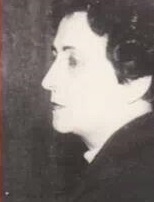Carmen Barradas facts for kids
Carmen Barradas (born March 18, 1888 – died May 12, 1963) was a talented musician from Uruguay. She was a pianist, a composer (someone who writes music), and a teacher who led choirs. She was known for her unique and experimental music.
Contents
Life Story
Early Life and Music
Carmen Barradas was born Maria del Carmen Pérez Jiménez in Montevideo, Uruguay. Her father, Antonio Pérez Giménez Barradas, was a painter. Carmen started learning music with Antonio Frank. When her father passed away in 1898, she had to stop her lessons for a while.
Later, with help from friends and family, she continued her studies at the Conservatorio del Uruguay. She earned her music diploma in 1915. Carmen chose the stage name "Carmen Barradas" to honor her younger brother, Rafael Barradas, who was a famous painter.
Moving to Spain
After World War I, Carmen's brother Rafael couldn't return to Uruguay from Spain. So, in 1916, Carmen and her family decided to move to Spain to be with him. It was a difficult journey, and they even had to apply to enter Spain as workers.
Once in Spain, Carmen and her mother worked hard making toys to support themselves. But Carmen also continued to develop her musical skills. She became an active part of the art scene in Barcelona. In 1917, she even performed a concert featuring her own musical pieces.
Return to Uruguay and New Ideas
Carmen lived and composed music in Spain until 1922. She then returned to Montevideo, Uruguay, with her family in 1928. There, she became a teacher at the Institutos Normales.
During this time, Carmen also created a children's magazine called Andresillo. This magazine was special because it included fun cartoons and songs for kids. Carmen was very creative and used new, experimental ways to write music. She used non-traditional graphic notation, which meant she drew symbols and shapes to represent music instead of just standard notes.
Carmen performed her own works at the famous Teatro Solís in 1934. She stopped composing new music in 1949 and passed away in Montevideo.
Her Legacy
Even though her music was called "brilliant," her experimental style was not always fully understood or accepted in Uruguay during her lifetime. Sadly, many of her musical works were lost after she died.
However, a talented pianist and music expert named retained and performed some of her scores. Today, about 170 of her musical manuscripts, some complete and some partial, still exist. They show her unique and innovative approach to music.
Musical Works
Here are some of Carmen Barradas's selected musical pieces:
- Fabricación (1922)
- Andaluza
- la niña de la mantilla blanca
- Aserradero
- Taller Mecánic
- En el molino y Procesión
- Aurora en la enramada
- Mar-Tragedia-Misterio
- Estudios tonales
See also
 In Spanish: Carmen Barradas para niños
In Spanish: Carmen Barradas para niños


